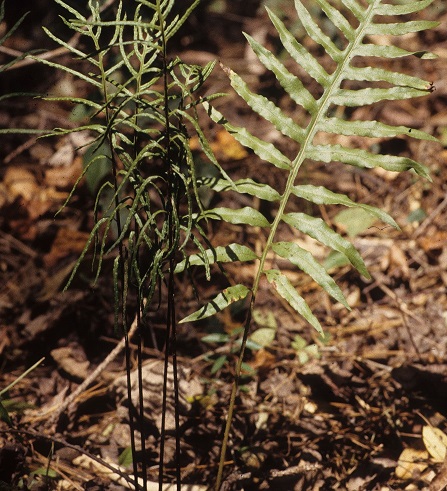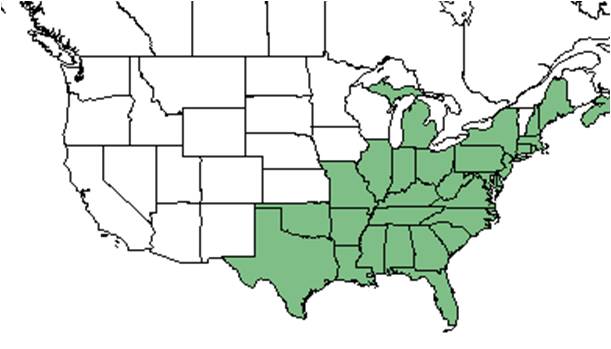Difference between revisions of "Lorinseria areolata"
(→Conservation and Management) |
HaleighJoM (talk | contribs) (→Ecology) |
||
| (5 intermediate revisions by 5 users not shown) | |||
| Line 18: | Line 18: | ||
}} | }} | ||
| − | Common name: | + | Common name: Netted chain fern<ref name="weakley">Weakley, A.S. 2015. Flora of the southern and mid-atlantic states. Working Draft of 21 May 2015. University of North Carolina at Chapel Hill, Chapel Hill, North Carolina.</ref> |
==Taxonomic notes== | ==Taxonomic notes== | ||
| − | + | Synonyms: ''Woodwardia areolata'' (Linnaeus) T. Moore.<ref name="weakley">Weakley, A.S. 2015. Flora of the southern and mid-atlantic states. Working Draft of 21 May 2015. University of North Carolina at Chapel Hill, Chapel Hill, North Carolina.</ref> | |
| + | |||
| + | Varieties: none.<ref name="weakley">Weakley, A.S. 2015. Flora of the southern and mid-atlantic states. Working Draft of 21 May 2015. University of North Carolina at Chapel Hill, Chapel Hill, North Carolina.</ref> | ||
==Description== | ==Description== | ||
<!-- Basic life history facts such as annual/perrenial, monoecious/dioecious, root morphology, seed type, etc. --> | <!-- Basic life history facts such as annual/perrenial, monoecious/dioecious, root morphology, seed type, etc. --> | ||
A description of ''Lorinseria areolata'' is provided in [http://www.efloras.org/florataxon.aspx?flora_id=1&taxon_id=233501357 The Flora of North America]. | A description of ''Lorinseria areolata'' is provided in [http://www.efloras.org/florataxon.aspx?flora_id=1&taxon_id=233501357 The Flora of North America]. | ||
| − | ''Lorinseria areolata'' is a perennial herbaceous species. It tends to grow erect, with a reticulated petiole that is straw colored, except at the base where it is brown | + | ''Lorinseria areolata'' is a perennial herbaceous species. It tends to grow erect, with a reticulated petiole that is straw-colored, except at the base where it is brown.<ref name="FSU Herbarium"/> This fern has a finely toothed, winged rachis and elliptic sori arranged in chains.<ref name="FSU Herbarium">Florida State University Robert K. Godfrey Herbarium database. URL: [http://herbarium.bio.fsu.edu http://herbarium.bio.fsu.edu]. Last accessed: June 2014. Collectors: Travis MacClendon, S. W. Leonard, Roy Komarek, Robert K. Godfrey, Loran C. Anderson, T. MacClendon, Boothes, and Annie Schmidt. States and Counties: Florida: Calhoun, Jackson, Leon, and Liberty. Georgia: Grady and Thomas.</ref> |
==Distribution== | ==Distribution== | ||
| + | ''L. areolata'' ranges from Novia Scotia to the Coastal Plains of southern Florida and east Texas, and west to Mississippi and Missouri.<ref name="weakley">Weakley, A.S. 2015. Flora of the southern and mid-atlantic states. Working Draft of 21 May 2015. University of North Carolina at Chapel Hill, Chapel Hill, North Carolina.</ref> | ||
==Ecology== | ==Ecology== | ||
===Habitat=== <!--Natural communities, human disturbed habitats, topography, hydrology, soils, light, fire regime requirements for removal of competition, etc.--> | ===Habitat=== <!--Natural communities, human disturbed habitats, topography, hydrology, soils, light, fire regime requirements for removal of competition, etc.--> | ||
| − | ''L. areolata'' can be found in longleaf pinelands, savannas, moist woodlands, cypress woods, shores of lakes, marshes, and ponds, and wooded ravines | + | ''L. areolata'' can be found in longleaf pinelands, savannas, moist woodlands, cypress woods, shores of lakes, marshes, and ponds, and wooded ravines.<ref name="FSU Herbarium"/> It can also occur in disturbed habitats like ditch banks.<ref name="FSU Herbarium"/> |
| − | |||
===Phenology=== <!--Timing off flowering, fruiting, seed dispersal, and environmental triggers. Cite PanFlora website if appropriate: http://www.gilnelson.com/PanFlora/ --> | ===Phenology=== <!--Timing off flowering, fruiting, seed dispersal, and environmental triggers. Cite PanFlora website if appropriate: http://www.gilnelson.com/PanFlora/ --> | ||
| − | + | This species fruits from May through September.<ref name="weakley">Weakley, A.S. 2015. Flora of the southern and mid-atlantic states. Working Draft of 21 May 2015. University of North Carolina at Chapel Hill, Chapel Hill, North Carolina.</ref> | |
| − | |||
<!--===Seed dispersal===--> | <!--===Seed dispersal===--> | ||
<!--===Seed bank and germination===--> | <!--===Seed bank and germination===--> | ||
===Fire ecology=== <!--Fire tolerance, fire dependence, adaptive fire responses--> | ===Fire ecology=== <!--Fire tolerance, fire dependence, adaptive fire responses--> | ||
| − | It occurs in | + | It occurs in habitats that are frequently burned, including pinelands and savannas, which implies some fire tolerance.<ref name="FSU Herbarium"/> |
<!--===Pollination===--> | <!--===Pollination===--> | ||
| − | <!--=== | + | <!--===Herbivory and toxicology===--> |
<!--===Diseases and parasites===--> | <!--===Diseases and parasites===--> | ||
| − | |||
| − | == | + | ==Conservation, cultivation, and restoration== |
| + | |||
| + | ==Cultural use== | ||
==Photo Gallery== | ==Photo Gallery== | ||
<gallery widths=180px> | <gallery widths=180px> | ||
| Line 50: | Line 52: | ||
==References and notes== | ==References and notes== | ||
| − | |||
Latest revision as of 18:41, 14 July 2022
| Lorinseria areolata | |
|---|---|

| |
| Photo taken by Gil Nelson | |
| Scientific classification | |
| Kingdom: | Plantae |
| Division: | Pteridophyta – Ferns |
| Class: | Filicopsida |
| Order: | Polypodiales |
| Family: | Blechnaceae |
| Genus: | Lorinseria |
| Species: | L. areolata |
| Binomial name | |
| Lorinseria areolata ((L.) T. Moore | |

| |
| Natural range of Lorinseria areolata from USDA NRCS Plants Database. | |
Common name: Netted chain fern[1]
Contents
Taxonomic notes
Synonyms: Woodwardia areolata (Linnaeus) T. Moore.[1]
Varieties: none.[1]
Description
A description of Lorinseria areolata is provided in The Flora of North America.
Lorinseria areolata is a perennial herbaceous species. It tends to grow erect, with a reticulated petiole that is straw-colored, except at the base where it is brown.[2] This fern has a finely toothed, winged rachis and elliptic sori arranged in chains.[2]
Distribution
L. areolata ranges from Novia Scotia to the Coastal Plains of southern Florida and east Texas, and west to Mississippi and Missouri.[1]
Ecology
Habitat
L. areolata can be found in longleaf pinelands, savannas, moist woodlands, cypress woods, shores of lakes, marshes, and ponds, and wooded ravines.[2] It can also occur in disturbed habitats like ditch banks.[2]
Phenology
This species fruits from May through September.[1]
Fire ecology
It occurs in habitats that are frequently burned, including pinelands and savannas, which implies some fire tolerance.[2]
Conservation, cultivation, and restoration
Cultural use
Photo Gallery
References and notes
- ↑ 1.0 1.1 1.2 1.3 1.4 Weakley, A.S. 2015. Flora of the southern and mid-atlantic states. Working Draft of 21 May 2015. University of North Carolina at Chapel Hill, Chapel Hill, North Carolina.
- ↑ 2.0 2.1 2.2 2.3 2.4 Florida State University Robert K. Godfrey Herbarium database. URL: http://herbarium.bio.fsu.edu. Last accessed: June 2014. Collectors: Travis MacClendon, S. W. Leonard, Roy Komarek, Robert K. Godfrey, Loran C. Anderson, T. MacClendon, Boothes, and Annie Schmidt. States and Counties: Florida: Calhoun, Jackson, Leon, and Liberty. Georgia: Grady and Thomas.